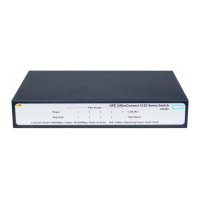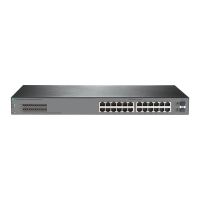8
ARP configuration examples
Example: Configuring a long static ARP entry
Network configuration
As shown in Figure 3, hosts are connected to Device B. Device B is connected to Device A through
interface GigabitEthernet 1/0/1 in VLAN 10.
To ensure secure communications between Device A and Device B, configure a long static ARP
entry for Device A on Device B.
Figure 3 Network diagram
Procedure
# Create VLAN 10.
<DeviceB> system-view
[DeviceB] vlan 10
[DeviceB-vlan10] quit
# Add interface GigabitEthernet 1/0/1 to VLAN 10.
[DeviceB] interface gigabitethernet 1/0/1
[DeviceB-GigabitEthernet1/0/1] port access vlan 10
[DeviceB-GigabitEthernet1/0/1] quit
# Create VLAN-interface 10 and configure its IP address.
[DeviceB] interface vlan-interface 10
[DeviceB-vlan-interface10] ip address 192.168.1.2 8
[DeviceB-vlan-interface10] quit
# Configure a long static ARP entry that has IP address 192.168.1.1, MAC address 00e0-fc01-0000,
and output interface GigabitEthernet 1/0/1 in VLAN 10.
[DeviceB] arp static 192.168.1.1 00e0-fc01-0000 10 gigabitethernet 1/0/1
Verifying the configuration
# Verify that Device B has a long static ARP entry for Device A.
[DeviceB] display arp static
Type: S-Static D-Dynamic O-Openflow R-Rule M-Multiport I-Invalid
IP address MAC address VID Interface/Link ID Aging Type
Device A
GE1/0/1
VLAN10
192.168.1.1/24
00e0-fc01-0000
Device B

